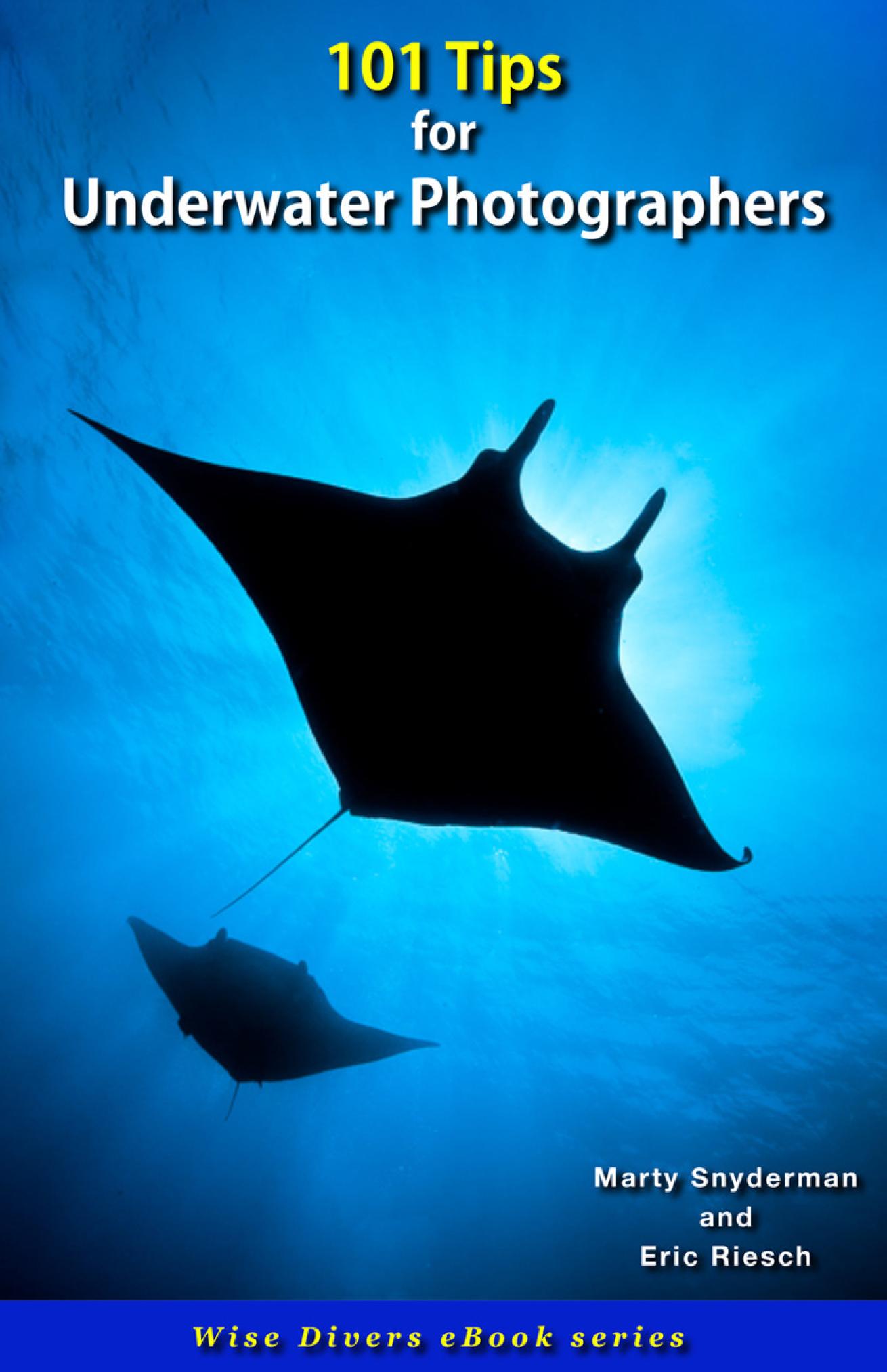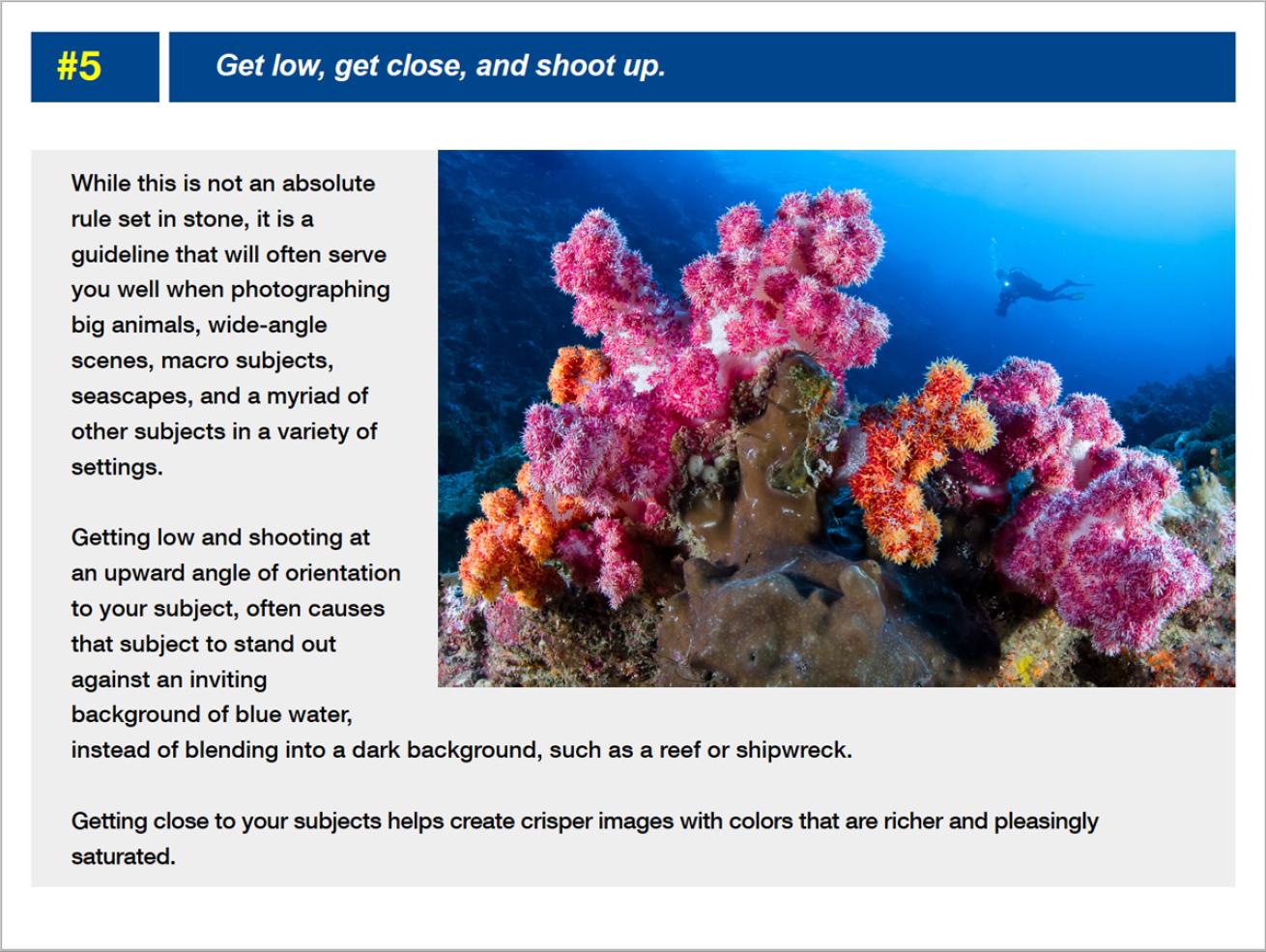Pro Shooters Offer 101 Tips for Underwater Photographers
What if a professional photographer with 40 years of underwater experience offered to help you shorten your learning curve and skip past a lot of the mistakes commonly made by new underwater shooters? And what if that advice included more than a few tips that might be good reminders for more-experienced photographers too?

Courtesy Marty Snyderman and Eric Riesch101 Tips for Underwater Photographers
That’s what underwater photographers Marty Snyderman and Eric Riesch aim to do with the first release in the new Wise Divers eBook series, 101 Tips for Underwater Photographers ($14.99 at Apple Books, Amazon or wisedivers.com).
Written and photographed by Snyderman and designed and edited by Riesch—the managing editor behind the definitive REEF Fish ID series popular with divers—101 Tips covers topics from pre-dive preparation to handling and care of equipment, the use of lighting and strobes, working with models, animal encounters, post-processing and more.
Q: There’s certainly a need for a book like this—what made you realize now was the time?
Eric Riesch: “Many of us divers are anxious to get back in the water, so the timing could not be better. This book is a perfect refresher for all of us to get our heads back in the game and get ready for our next underwater photography trip.”
Q: This is aimed at beginner to advanced shooters—how did you approach speaking to both in a single guide?
Marty Snyderman: “I have taught underwater photography, given presentations and written for broad audiences for years—classes and audiences almost always consist of divers with widely varied backgrounds. Some have a lot of camera experience and very little diving experience, or vice versa. Some dive in water where great conditions are common, while some have never seen more than 25-foot visibility and never dived in anything but a drysuit.
“Reminders are often helpful, especially for activities that even ‘advanced shooters’ don’t get to participate in every day. Our skills get rusty if we don’t use them, and it’s easy to overlook things that used to be in the forefront of our minds.”
Q: The guide also includes mistakes to avoid — what’s the No. 1 most common mistake among rookie shooters? And advanced shooters?
Snyderman: “There’s a tendency for beginning shooters to fail to learn photographic fundamentals while expecting their camera system to ’take’ photographs that please them. But you really can’t buy your way to consistent success in underwater photography. From the get-go, beginners often want to capture scenes that require coordinating the use of strobes and sunlight to acquire a proper exposure—photographs that involve this scenario are the most complicated, and it takes some practice and analysis to develop the required skills.
“Complacency is the No. 1 mistake made by experienced shooters. Instead of reviewing images and thinking about skills, experienced shooters seem to assume those skills have been ‘mastered’ and will be as sharp as they were on the last day of their previous trip the next time they use their camera system. I try to make that point in my classes by reminding students that Hank Aaron took batting practice daily, and Michael Jordan and Larry Bird shot free throws every day. Brain and muscle memory are fundamentally important to underwater photographers.”
Riesch: “Mistakes can actually be a good opportunity to learn. One of our tips (#29) addresses this, and encourages underwater photographers to review their mistake shots before each trip. We also give strategies on how photographers can avoid common mistakes with good preparation (#38).”

Courtesy Marty Snyderman and Eric RieschExcerpt from 101 Tips for Underwater Photographers
Q: The photo editing is tremendous in 101 Tips — they really tell the story. How did you choose the shots?
Snyderman: “Thank you! Most of the images came from my classes, presentations and articles. I am always adding to or tinkering with the example photographs I use. I have kept a collection of my mistakes over the years, and in other instances, I have intentionally shot some ‘don’t do this or this will happen’ examples. That said, I presented Eric with some options and he selected images that he thought worked best with the text and layout.”
Riesch: “Going through Marty’s beautiful images and creating a layout to complement his work was my favorite part of the process. We wanted to present our tips in an easy-to-use format, immediately available at the top of each page. Below each, we give examples and more information, including photos with almost every tip. Our eBooks were created to be used on Apple and Amazon Kindle products and are best viewed on a tablet or laptop.”
Q: How did you and Marty come to work together on this?
Snyderman: “I first met Eric through his work at New World Publications. I think I have and use all of New World’s ID and behavior books. Later I served on the Board of Trustees of REEF (Reef Environmental Education Foundation), and I often called to speak with Anna and Ned DeLoach and Paul Humann at New World. When Eric answered the phone, we often talked fish and sports.”
Riesch: “Marty and I dove together at the Blue Heron Bridge and in the Florida Keys. We formed a good friendship through our mutual love for diving. When this opportunity came about, I spoke with Anna DeLoach, who has experience working with both Marty and me. Anna thought our personalities complemented each other and that we would work well together —boy, was she right!
Q: Among the 101 tips, which of these principles or lessons has made the most difference in your own underwater photography?
Snyderman: “I’d have to say #2: Enjoy the entire photographic process, not just your processed images. Early on in my career, I felt a self-imposed pressure to photograph every animal and every behavior in every destination I visited, even if I was only there for a week or so. Well, no surprise, that didn’t happen. I needed to learn to let go of that unrealistic expectation and to be sure I enjoyed just being in the ocean and seeing whatever I saw. This philosophy has enabled me to maximize my diving experiences.”
Riesch: “My mentors Paul Humann and Ned DeLoach repetitively taught me to get close (#4), spend time with a subject (#8) and to learn about my subject (#74). I would have to say when starting my underwater photography, I learned the hard way about strobe placement (# 57) and minimizing backscatter (#62). I wish I had had a book like this when I started!”
Q: When will Wise Divers’ upcoming Amazing Animals series be available, and what’s next after those?
Snyderman: “The first two books in our Amazing Animals series will be available to order in May. As for what’s next, we are very excited to be working with some other author-photographers on more eBooks, and have more titles of our own on the docket as well. We want to be sure we enjoy the creating and publishing process, not just the finished eBooks.
Riesch: “The Amazing Animals set will be a giant wish list for what experience divers might see on future dives. It is also intended as an encouragement for nondivers and future generations of divers to learn about what lives below the waves. Thank you to everyone who has purchased our books and supported our work. You can follow us on Facebook or Instagram to be the first to hear about our next books. More information is also available on our website at wisedivers.com.”










